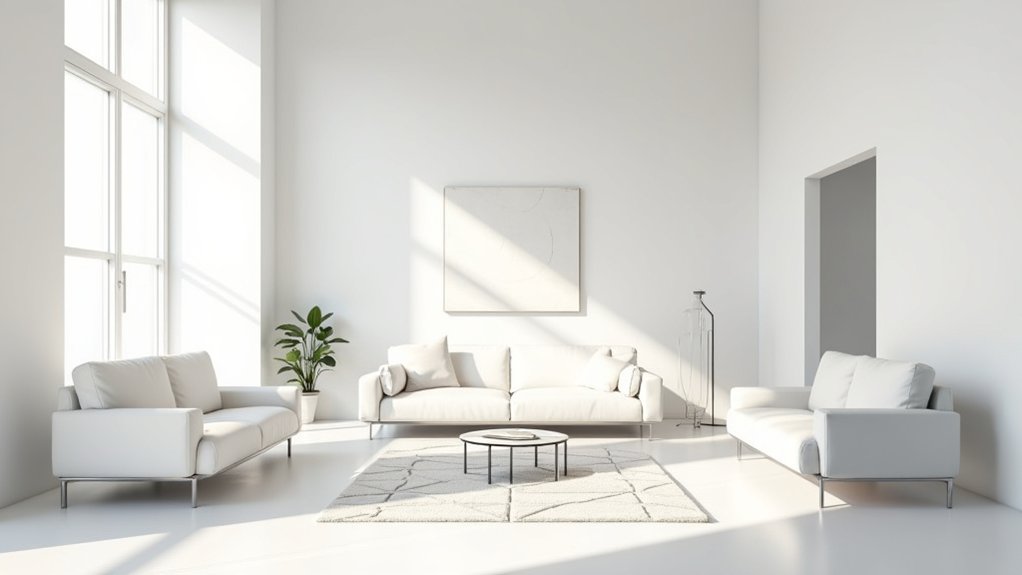
18 White Living Room Ideas That Are Modern and Minimalist
Modern minimalist white living rooms thrive on visual clarity and spatial harmony. Key ideas include streamlined modular seating, performance white furnishings for durability, and an interplay of layered textures for warmth. Expansive glazing and reflective surfaces accentuate natural light, while curated gallery walls and sculptural lighting establish focal points. Monochromatic palettes serve as a serene backdrop for bold art, organic greenery, or architectural detailing. Exploring further reveals how to manipulate scale, proportion, and tailored accents for striking, livable results.
Key Takeaways
- Opt for minimalist, modular white sofas and performance fabrics to create a sleek, spacious look that’s both durable and inviting.
- Layer plush rugs, bouclé cushions, and cozy throws in varying textures to add warmth and depth to an all-white palette.
- Maximize natural light with sheer curtains, floor-to-ceiling windows, and reflective surfaces like mirrors or glossy finishes for a luminous, airy feel.
- Curate a gallery wall or display oversized statement art in cohesive colors to introduce personality while maintaining minimalist harmony.
- Incorporate sculptural lighting, metallic accents, and intentional architectural details to highlight clean lines and create visual interest within a modern white space.
Embrace Minimalist Furniture
By integrating minimalist furniture, a white living room achieves visual clarity and spatial harmony through the strategic use of clean lines and functional forms.
Minimalist design in a white room prioritizes an uncluttered aesthetic, often utilizing low-profile modular sofas that expand seating capacity while visually elongating the space.
Low-profile modular sofas in a white room enhance spaciousness and seating, embodying the essence of minimalist, uncluttered design.
Multi-functional pieces, such as ottomans with hidden storage, reinforce efficient spatial planning without deviating from the minimalist ethos.
Statement furniture—sculptural chairs or geometric coffee tables—serves as a focal point, offering visual interest yet maintaining restraint.
Limiting the number of furnishings preserves an airy environment, allowing each carefully chosen element to stand out.
This curated approach to furniture selection establishes a balanced composition that leverages the inherent brightness and expansiveness of a white room.
Neutral color palettes create a calming ambiance and allow for experimentation with textures and materials, adding depth to the minimalist design.
Layer Different Textures
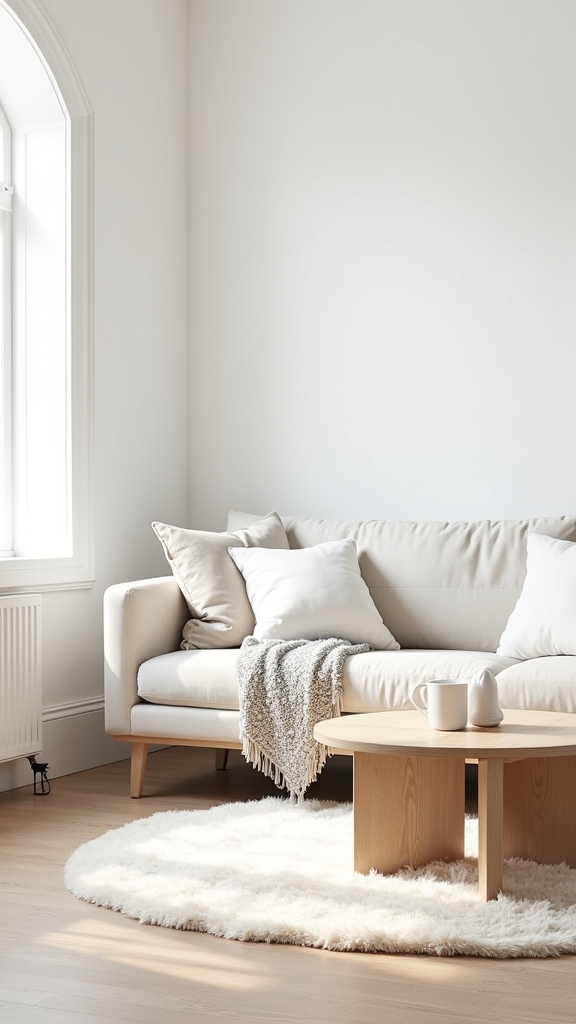
While a monochromatic palette imparts serenity and openness, layering diverse textures is crucial for infusing a white living room with visual depth and tactile richness.
Expert designers strategically juxtapose plush rugs, bouclé cushions, and tasselled pouffes to break the uniformity of white tones, generating a dynamic interplay of surfaces. The integration of soft textiles with sleek, hard elements—such as a minimalist coffee table or metallic accents—establishes a balanced contrast that enhances visual interest.
Introducing contrasting textiles like silk and chunky knits can further enrich the dynamic contrast, providing warmth and cohesion in the design.
This deliberate mix not only boosts the room’s aesthetic sophistication but also cultivates a cozy ambiance, inviting relaxation and warmth. Employing varied textures guarantees the space feels lived-in and welcoming without compromising its minimalist ethos.
Ultimately, textural layering is paramount for achieving both comfort and design refinement in contemporary white living rooms.
Incorporate Natural Light
Maximizing window exposure is fundamental to accentuating the luminous quality of a white living room, enabling daylight to permeate and visually expand the space.
Reflective surfaces—such as mirrored accents or high-gloss finishes—further amplify brightness, reinforcing a sense of spaciousness and clarity.
Strategic integration of these elements enhances the room’s minimalist aesthetic while maintaining a harmonious, light-filled environment.
Maximize Window Exposure
When natural light is allowed to flood a white living room, the resulting interplay of brightness and open space is accentuated, reinforcing the room’s sense of volume and serenity.
To maximize window exposure, designers frequently advocate for expansive glazing solutions such as floor-to-ceiling windows or sliding glass doors. This architectural strategy guarantees abundant natural light permeates the interior, amplifying the visual impact of white surfaces and heightening spatial perception.
Minimalist window treatments—like sheer curtains or the absence of coverings altogether—preserve the purity of light, eliminating visual clutter and supporting the minimalist ethos.
Furniture should be arranged to avoid obstructing the windows, maintaining an uninterrupted light flow. This deliberate planning cultivates an inviting, open environment that underscores modern minimalism’s core emphasis on clarity and spatial harmony.
Reflective Surfaces for Brightness
Building on the impact of abundant natural light, integrating reflective surfaces becomes a strategic approach to intensifying luminosity within a white living room. Expertly positioned oversized mirrors not only introduce visual depth but also multiply daylight, fostering a distinctly light and airy ambiance.
Mirrored furniture—such as coffee tables and side tables—delivers both functional elegance and additional reflection, reinforcing the minimalist aesthetic while amplifying the perception of openness. Glass décor and accessories, chosen in pale or neutral hues, contribute subtle radiance by dispersing sunlight across the space.
The synergy between reflective surfaces and expansive windows maximizes brightness, while a restrained color palette guarantees cohesion. This deliberate interplay of material and placement yields a revitalizing environment, emphasizing spatial clarity and modern minimalism.
Curate a Gallery Wall
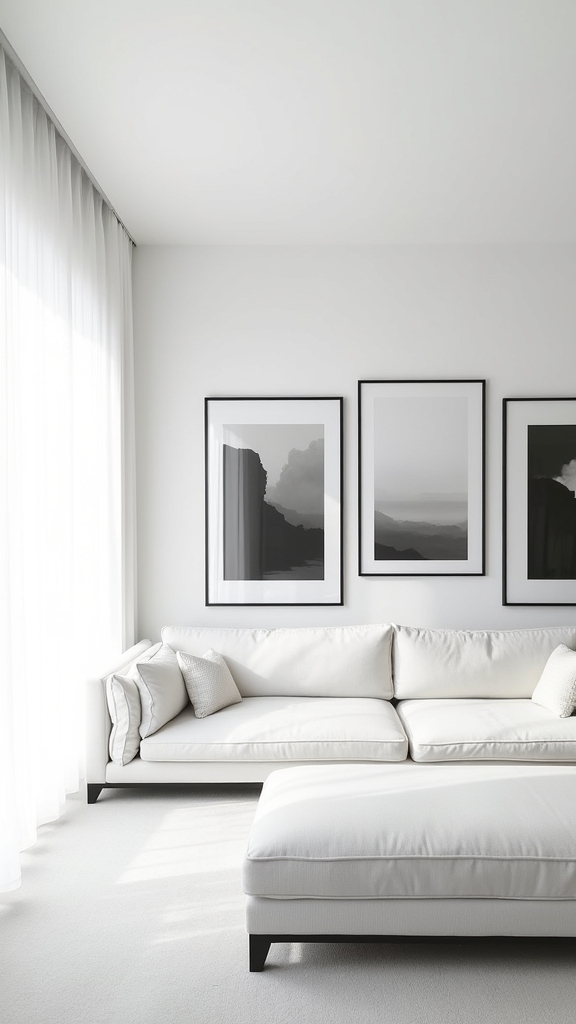
A thoughtfully curated gallery wall in a white living room relies on the intentional selection of artworks unified by palette or theme, ensuring visual cohesion.
Strategic arrangement—whether grid or salon-style—establishes balance and rhythm across the expanse, allowing each piece to contribute to the overall composition.
Incorporating a variety of mediums and frame profiles introduces subtle texture and depth while preserving the minimalist integrity of the space.
Selecting Cohesive Artworks
Curating a gallery wall in a white living room leverages the room’s minimalist foundation to amplify the visual impact of selected artworks. Expert curation begins with selecting a cohesive theme or color palette, ensuring artworks harmonize with both each other and the restrained palette of the space. Emphasizing a blend of mediums—such as photography, paintings, and illustrative prints—introduces visual interest while respecting minimalist sensibilities. Frame choices should remain neutral, with subtle variations in size and profile to maintain unity and prevent visual clutter. The following table outlines key considerations:
| Theme/Palette | Mediums Included | Frame Selection |
|---|---|---|
| Monochrome | Photography | Matte black frames |
| Earthy neutrals | Watercolor paintings | Natural wood frames |
| Graphic contrast | Abstract prints | White gallery frames |
| Soft pastels | Mixed media | Thin metal frames |
Arranging for Visual Balance
While the minimalist canvas of a white living room provides a serene backdrop, achieving visual balance in a gallery wall requires deliberate adherence to design principles.
The key lies in curating a gallery wall that injects visual interest without disrupting the tranquility of the space. Strategic arrangement—whether employing a precise grid or an intentionally asymmetrical layout—ensures equilibrium, while consistent spacing establishes order and cohesion.
Integrating framed and unframed pieces activates both texture and dimension, preventing flatness against the white backdrop. Selecting artworks in varied sizes and maintaining a unified color palette amplifies depth while reinforcing harmony.
Incorporating personal elements—such as photographs or subtle wall-mounted sculptures—allows for individual expression, yet aligns with minimalist aesthetics. Through meticulous composition, the gallery wall becomes a dynamic yet balanced focal point.
Mixing Mediums Creatively
Gallery walls in modern white living rooms achieve heightened visual interest through the intentional interplay of mixed mediums—paintings, photographs, and sculptural elements—arranged within a unified color palette.
In a minimalist living room, the gallery wall acts as a curated expression of personal style while adhering to clean lines and visual restraint. Employing a monochromatic scheme guarantees the collection integrates seamlessly with the white backdrop, preventing visual clutter.
Texture is introduced through varied frames and three-dimensional pieces, deepening the sensory experience.
- The juxtaposition of matte canvas, glossy photographs, and tactile sculptures evokes a nuanced emotional response.
- Strategic placement above a sofa or console table creates a focal anchor, drawing the eye with intentionality.
- Cohesive yet diverse elements invite contemplation, balancing serenity and intrigue within the minimalist living room.
Use Statement Lighting
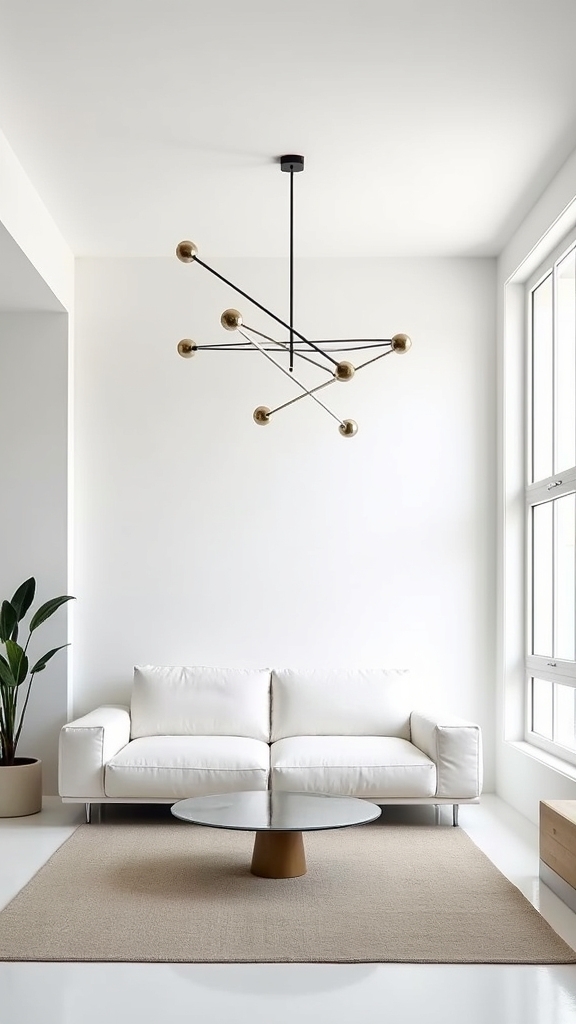
Often, statement lighting functions as both a sculptural element and a practical necessity, anchoring the minimalist aesthetic of a white living room.
In modern design, oversized pendant fixtures or sculptural floor lamps transcend mere illumination, acting as functional art that reinforces clean architectural lines. The layering of lighting—integrating ambient, task, and accent sources—creates visual depth and mitigates starkness, while metallic finishes such as brass or gold infuse warmth into a monochromatic palette.
Strategic fixture placement accentuates focal points, drawing attention to architectural details or curated artwork without disrupting the room’s serenity. Incorporating dimmers further refines the lighting experience, allowing for adaptable ambiance that shifts seamlessly between functional and atmospheric. To enhance the living room’s coziness, consider using warm color temperatures that mimic the tranquility of sunset and promote social interaction.
Consequently, statement lighting becomes integral to both the aesthetic and utility of a minimalist white living space.
Add Cozy Throws and Pillows
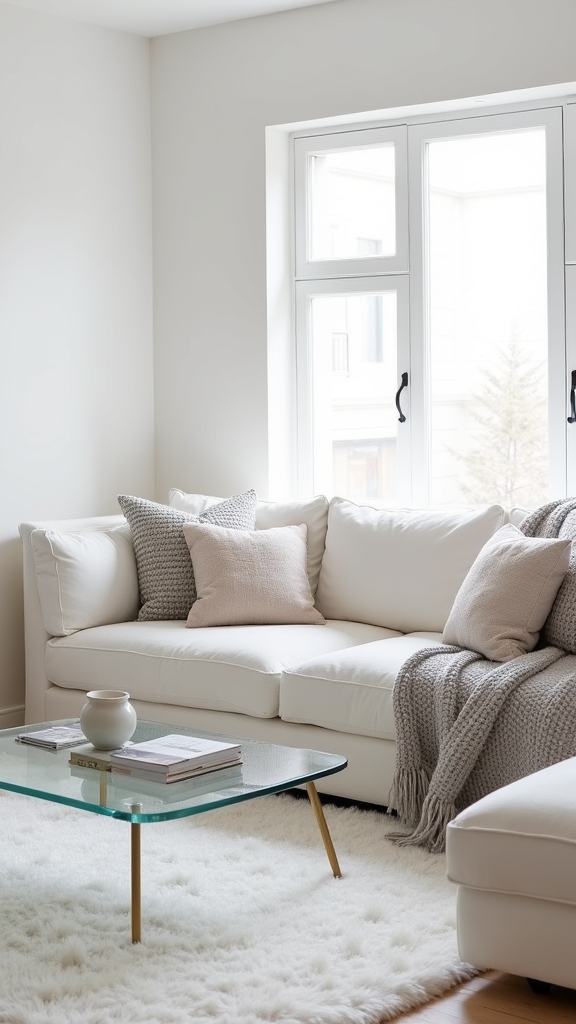
Introducing an array of throws and pillows in varying textures—such as boucle, linen, and velvet—infuses tactile warmth into a restrained white palette. Strategic layering of soft textiles, combined with subtle pattern mixing, establishes visual hierarchy and depth without compromising minimalist intent. This approach enhances comfort while reinforcing the room’s sophisticated, curated aesthetic. Incorporating plush textiles like soft throw blankets and oversized cushions further elevates the cozy ambiance of the minimalist living room.
Layer Textures for Warmth
A thoughtful layering of textures—plush throws, boucle cushions, and tasselled pouffes—transforms a minimalist white living room into a richly inviting environment.
By integrating tactile surfaces and soft materials, designers enhance the sensory appeal of a space that might otherwise feel stark or sterile.
Layer textures intentionally by selecting cozy throws in luxurious knits or faux fur, draping them over streamlined seating for both warmth and visual depth.
The introduction of varied textiles not only disrupts the monotony of all-white palettes but also enhances comfort and approachability.
- Drape sumptuous, cozy throws over sofas and accent chairs to evoke a sense of warmth and relaxation.
- Incorporate tactile cushions in boucle, linen, or velvet for subtle contrast.
- Anchor the room with a textured rug, grounding the minimalist scheme while amplifying the sense of coziness.
Mix Patterns for Interest
While a white living room exudes clarity and serenity, the strategic use of patterned throws and pillows introduces nuanced visual rhythm and depth.
Mixing patterns—such as subtle stripes or geometric motifs—creates visual interest without disrupting the minimalist ethos. Expertly curated, these accents layer dimension and warmth, complementing the monochromatic base while preventing aesthetic monotony.
Choosing patterns in a restrained, complementary color palette maintains harmony, ensuring the space remains cohesive. Incorporating diverse materials, such as velvet pillows or knitted throws, enhances tactile contrast and amplifies the sense of comfort.
Seasonal rotation of patterned accessories keeps the environment dynamic and current. Ultimately, to mix patterns successfully is to balance personality with restraint, yielding a white living room that feels inviting, sophisticated, and visually engaging.
Highlight Architectural Details
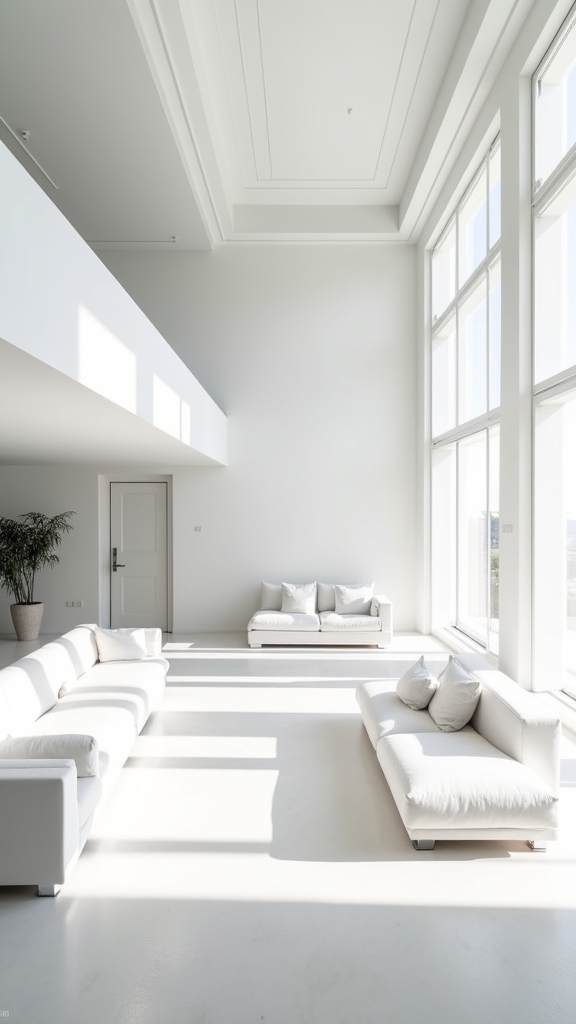
Architectural detailing serves as the foundation for elevating a white living room, directing focus to features such as crown molding, baseboards, and exposed ceiling beams.
By emphasizing these architectural details, a minimalist aesthetic gains visual intrigue without compromising clarity or cohesion. Trim and moldings introduce refined lines that articulate the room’s geometry, while built-in shelving integrates storage seamlessly, echoing the architecture in a functional yet understated manner.
Architectural details bring subtle intrigue to minimalist spaces, uniting storage and style while preserving clarity and cohesion.
Subtle contrasts—such as accentuating window frames or archways with varied materials—add depth while preserving simplicity.
- Crisp crown molding defines boundaries, evoking elegance and precision.
- Bespoke built-ins foster a curated environment, balancing form and utility.
- Contrasting architectural elements generate focal points, instilling a sense of identity and warmth within the minimalist context.
Each detail enriches the spatial narrative, reinforcing harmony.
Choose Performance White Furnishings
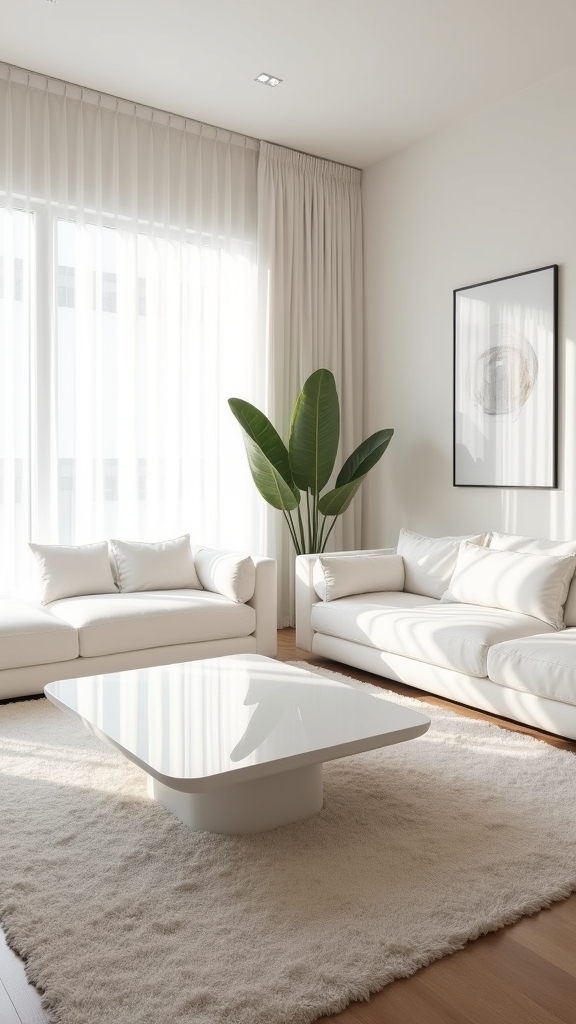
Selecting performance white furnishings introduces both resilience and refinement to a minimalist living room. These pieces are crafted from advanced materials—such as polyester and treated cotton blends—that are engineered for durability, stain resistance, and ease of maintenance.
Performance white furnishings allow for a pristine, luminous palette while reducing the stress of everyday wear. Integrated UV protection in many modern designs preserves the vivid white hue, preventing discoloration even in sunlit interiors.
The sleek and unembellished silhouettes typical of modern design are further enhanced by the crisp, uninterrupted surface of performance fabrics. Investing in high-quality performance white furnishings not only boosts visual impact but also guarantees longevity and practicality, aligning with minimalist principles by minimizing the need for frequent replacement or intensive cleaning routines.
Mix Warm Wood Accents
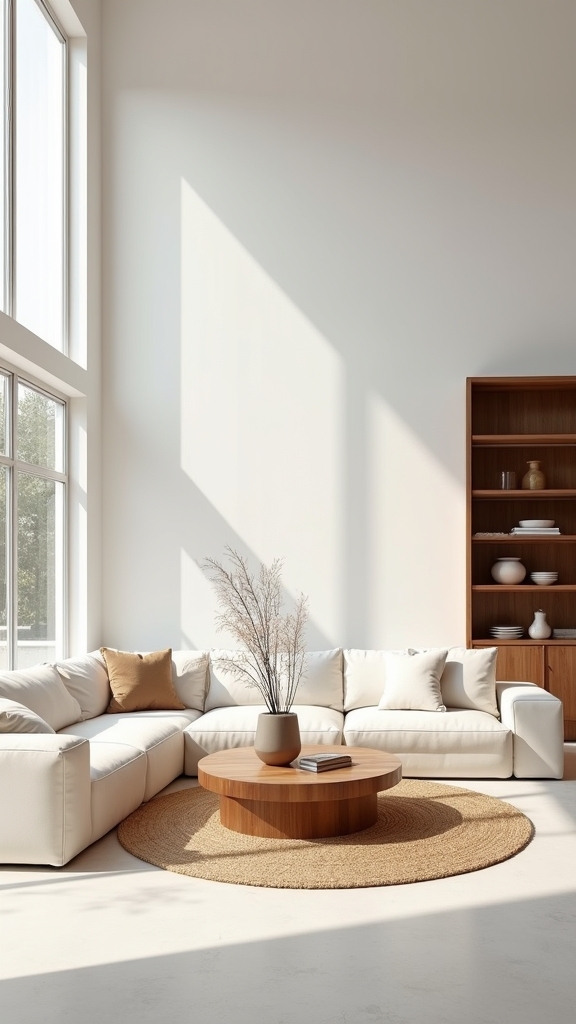
How can warmth and depth be achieved in a minimalist white living room? The strategic integration of warm wood accents is essential for transforming a stark space into one that feels both warm and inviting.
By utilizing the organic texture and natural hues of light wood—such as oak or birch—designers can soften the visual austerity of white interiors, cultivating a harmonious balance. Light wood surfaces maintain luminosity while injecting subtle sophistication and tactile appeal. Embracing an earthy color palette featuring warm shades like beige and terracotta can further enhance the inviting atmosphere of a minimalist white space.
To evoke an emotional response through design:
- Incorporate light wood furniture to introduce natural warmth and elegance.
- Layer in mixed wood finishes—pairing light wood with darker accents—to create visual depth and cohesion.
- Use wooden shelving or decorative touches to enrich the space without compromising minimalist principles.
These nuanced touches guarantee lasting comfort and timeless style.
Experiment With Two-Tone Walls
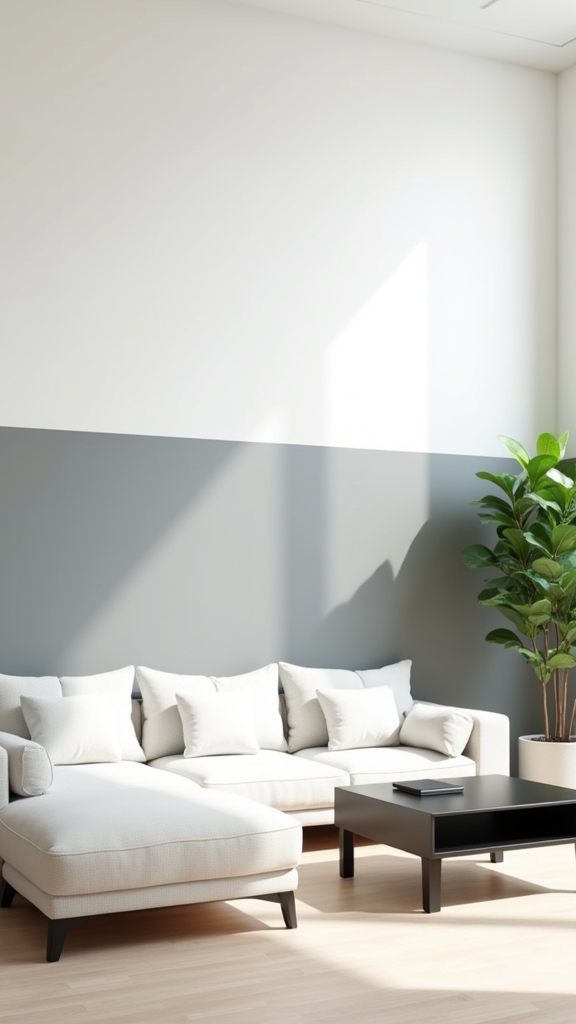
When executed with precision, two-tone walls in neutral palettes introduce subtle contrast and spatial depth to a minimalist white living room. This advanced design approach leverages the interplay between lighter and darker hues—often within the same color family—to add dimension without disrupting the serene effect of white walls. By employing two-tone walls, architectural features gain emphasis, and open-concept layouts achieve refined delineation. Incorporating layered lighting can further enhance the visual depth and mood of the space, offering adjustable brightness and highlighting key design elements.
| Element | Effect |
|---|---|
| Light–dark gradients | Enhances spatial perception |
| Neutral color families | Maintains visual cohesion |
| Defined shifts | Highlights architectural boundaries |
| Reflective surfaces | Amplifies brightness and openness |
Strategic placement of two-tone walls, especially when paired with reflective surfaces and abundant natural light, maximizes luminosity and enhances the minimalist ethos. The result is a harmonious, structured environment that never feels stark or monotonous.
Add a Bold Pop of Color
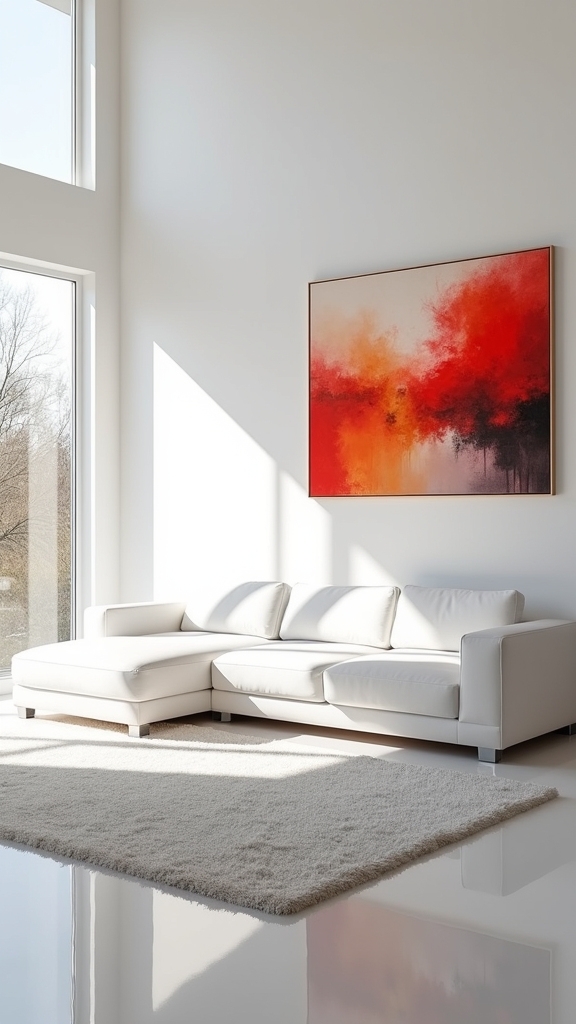
Introducing vibrant accent furniture, such as a statement armchair or a boldly colored coffee table, instantly punctuates a white living room with dynamic visual interest.
Eye-catching artwork featuring saturated hues creates a focal point and reinforces the spatial hierarchy within the minimalist palette.
Both strategies employ contrast and color theory to balance cohesion with lively expression.
Incorporating textured fabrics like velvet and leather adds depth and richness to the overall design.
Vibrant Accent Furniture Choices
While a white living room establishes a serene and minimalist canvas, the strategic introduction of vibrant accent furniture instantly enhances visual interest and depth.
Thoughtfully selected accent pieces—such as a bright yellow armchair or a deep blue sofa—create a compelling focal point, punctuating the space with color while adhering to minimalist design ethos.
To evoke an emotional response and amplify the room’s character, consider these expert choices:
- Statement Ottomans or Coffee Tables: Incorporate bold-hued ottomans or coffee tables for playful energy, injecting color without disrupting visual clarity.
- Rich Jewel-Toned Accent Chairs: Opt for chairs in emerald green or ruby red to establish a luxurious contrast against the white palette.
- Interchangeable Textiles: Use vibrant throw pillows or blankets for dynamic, seasonal color shifts while maintaining minimalist simplicity.
Eye-Catching Artwork Displays
How does bold wall art transform a white living room from understated to unforgettable? Expert designers emphasize that integrating vibrant wall art establishes a compelling focal point within a minimalist white living room. The interplay of vivid hues against crisp white walls enhances spatial energy and boosts overall ambiance. Oversized canvases or curated gallery walls introduce depth, preventing the space from appearing sterile while maintaining a clean, modern aesthetic. Contrasting tones maximize visual impact and reinforce architectural simplicity. Thoughtful curation of artwork allows individual expression and amplifies the room’s personality.
| Artwork Type | Visual Impact | Design Principle |
|---|---|---|
| Oversized Canvas | Dramatic statement | Scale & proportion |
| Gallery Wall | Layered interest | Rhythm & repetition |
| Colorful Prints | Dynamic focal point | Contrast & balance |
Strategic wall art transforms a white living room into a vibrant masterpiece.
Showcase Sculptural Decor
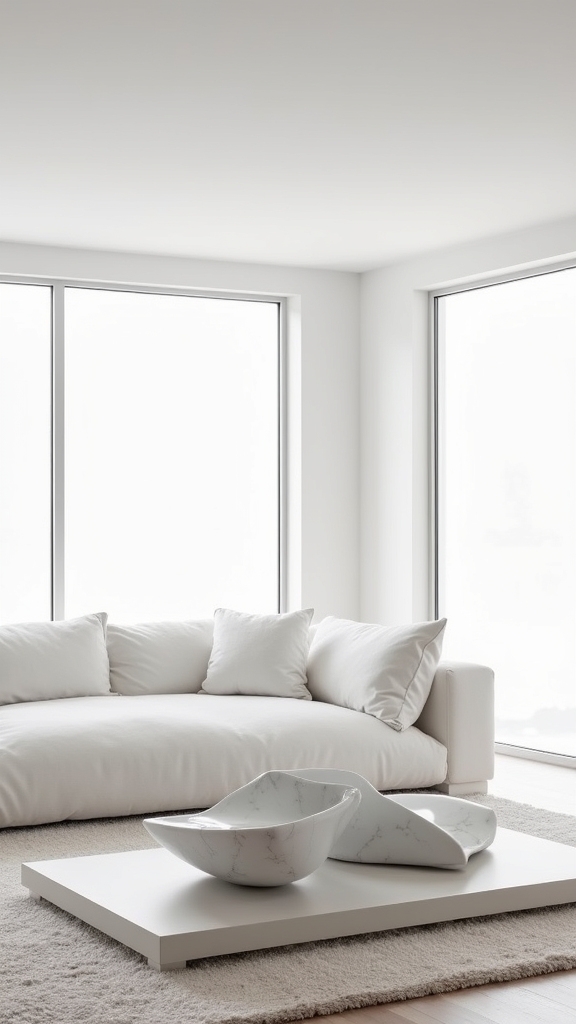
Sculptural decor transforms a white living room into a curated gallery, emphasizing form, proportion, and spatial harmony. By introducing statement pieces, the minimalist palette is enhanced through intriguing silhouettes and textural contrasts.
Expertly chosen sculptural decor—whether in the form of avant-garde accent chairs, architectonic coffee tables, or abstract art objects—offers visual punctuation without overwhelming the purity of the space.
- Oversized ceramic or metal vases become focal points, their contours accentuated by the crisp white backdrop, sparking a sense of awe and curiosity.
- Functional sculptural elements like sinuous shelving or geometric light fixtures provide both utility and artistic impact, uniting beauty with purpose.
- Each object’s placement is intentional, encouraging pause and admiration, and inviting a deeper emotional connection to the white living room’s serene narrative.
The use of bold geometric patterns in wall decor can further enhance the minimalist aesthetic by adding a layer of visual interest and complexity without compromising the room’s clean and serene ambiance.
Incorporate Reflective Surfaces
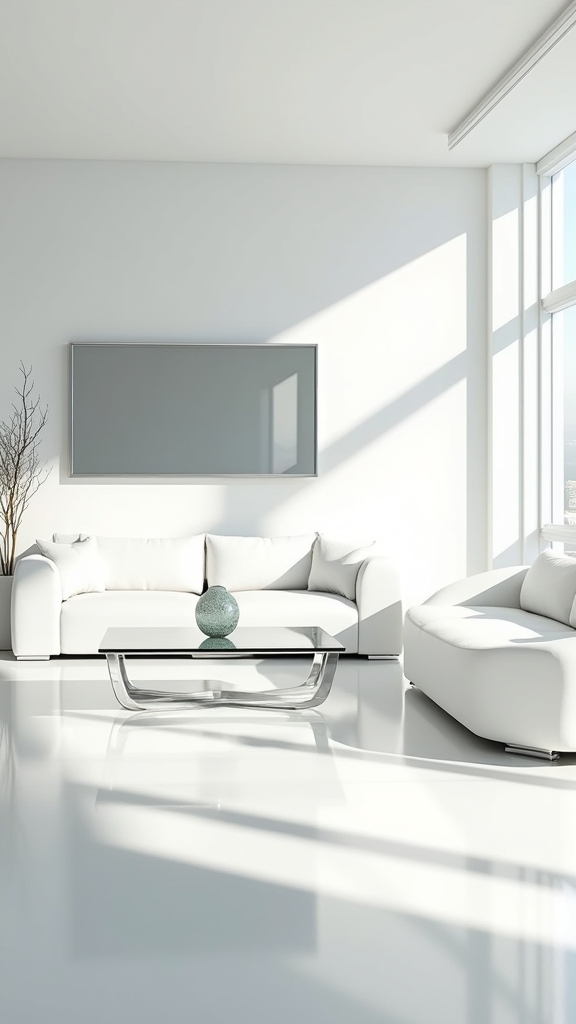
Incorporating reflective surfaces is a strategic technique to amplify natural light and visually expand a white living room.
Oversized mirrors and modern mirror accents enhance room depth while maintaining a streamlined, minimalist aesthetic.
These elements not only serve as focal points but also optimize spatial luminosity and design cohesion.
Amplify Natural Light
While harnessing a restrained palette, the strategic introduction of reflective surfaces—such as mirrors, glossy furniture, and polished metals—maximizes the diffusion of natural light in a white living room.
These elements are essential for curating a space that feels expansive yet serene. Expert placement of mirrors, particularly opposite windows, capitalizes on daylight, doubling perceived luminance and visually enlarging the room. High-gloss white finishes and polished metals not only reinforce minimalist aesthetics, but also reduce reliance on artificial lighting during daylight hours.
To evoke a sense of luminous tranquility, consider:
- Positioning a large mirror to directly reflect exterior light sources for heightened brightness.
- Selecting white, light-reflective finishes for cabinetry and walls to sustain a seamless visual flow.
- Integrating glass or chrome accent pieces for dynamic light interplay.
Enhance Room Depth
Through the deliberate integration of reflective surfaces, a white living room achieves enhanced spatial depth and visual intrigue. Expertly chosen glossy furnishings, mirrored shelving, and glass decor amplify the perception of expansiveness by capturing and redirecting ambient light.
When reflective surfaces are strategically positioned, especially opposite windows, they maximize natural illumination and intensify the open quality inherent to minimalist interiors. The interplay of glass, polished metal, and lacquered finishes generates layered reflections, subtly enriching the room’s textural narrative without detracting from its simplicity.
These elements serve as understated focal points, drawing the eye and establishing visual rhythm. By employing reflective surfaces to enhance depth, designers can boost the sophistication and dimensionality of a white living room while maintaining its serene, modernist ethos.
Modern Mirror Accents
Mirror accents function as both practical and aesthetic devices in the modern white living room, utilizing reflective surfaces to boost spatial luminosity and perceived volume.
Oversized mirrors strategically positioned across from windows maximize daylight penetration, transforming light into a key architectural element.
Mirrored furnishings—such as coffee tables and side tables—offer a chic, modern allure while preserving the room’s minimalist ethos.
Expertly chosen decorative mirror frames introduce subtle texture and visual intrigue, reinforcing the clean geometry of the space without disrupting its serene simplicity.
To evoke heightened emotion and visual interest, consider:
- Positioning a large mirror to reflect sunlight and expand spatial perception.
- Selecting mirrored furniture for a sophisticated, modern accent.
- Incorporating mirrors with distinctive frames to add subtle, artistic flair.
These principles guarantee a luminous, harmonious environment.
Opt for Patterned Rugs
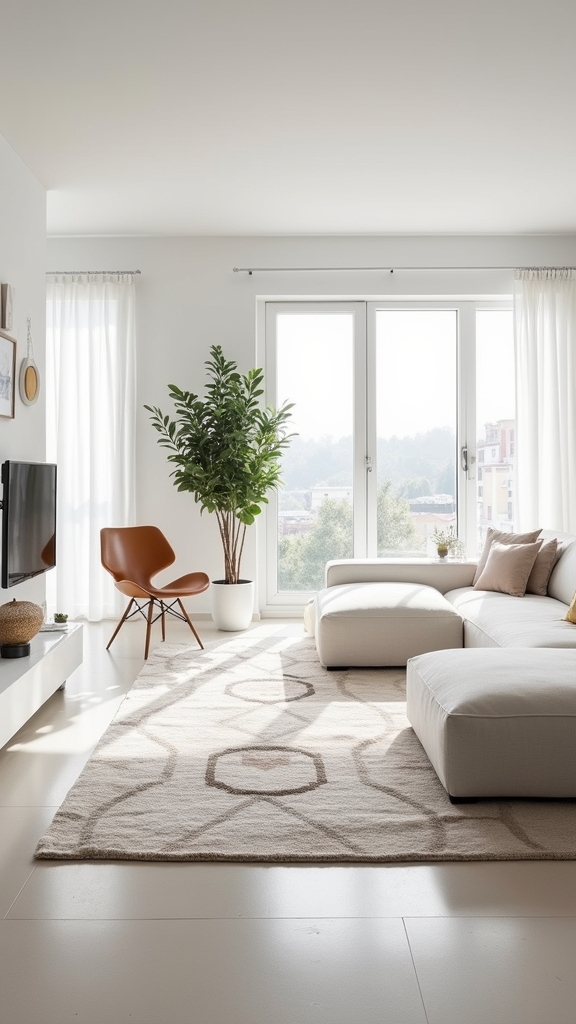
A patterned rug introduces both visual intrigue and tactile warmth to a white living room, acting as an intentional focal point within the minimalist framework. Thoughtfully selected patterned rugs enhance visual interest without disrupting the tranquil atmosphere essential to modern minimalism. Subtle motifs or muted hues guarantee that the design remains serene while providing a nuanced layer of texture underfoot. Geometric and abstract patterns, in particular, resonate with contemporary furniture lines, reinforcing spatial cohesion and design unity. Layered lighting showcases wall decor effectively, enhancing the room’s aesthetic while maintaining its minimalist charm. Layering a patterned rug atop a neutral base enhances dimensionality and creates an inviting sense of comfort. Additionally, rotating rugs seasonally offers a dynamic approach to decor, allowing the space to evolve while preserving its minimalist character. This strategy keeps the room visually compelling and comfortably modern.
Display High-Impact Art
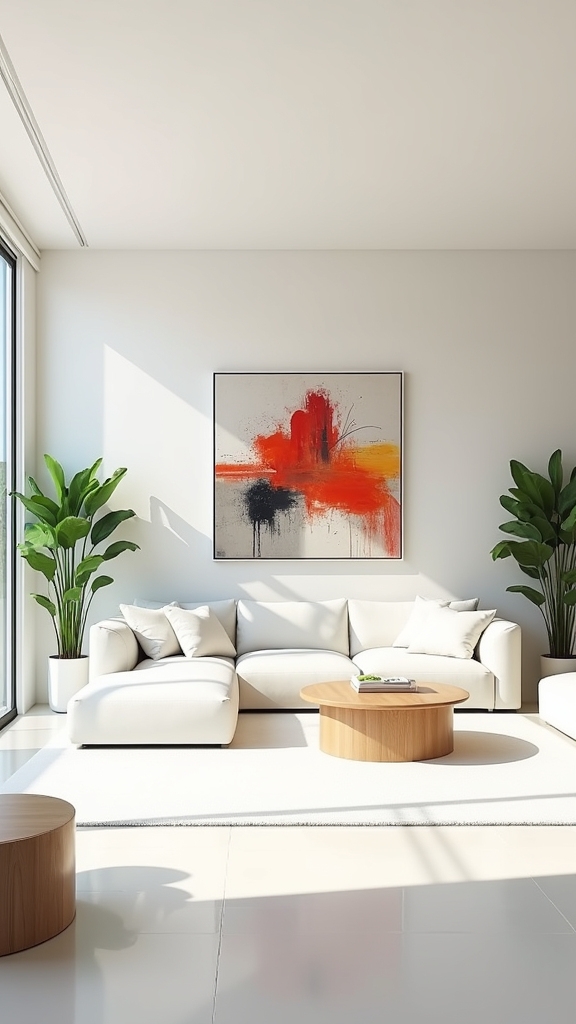
While the purity of white walls establishes a serene backdrop, introducing high-impact art immediately animates the space and asserts a distinct focal point.
In a minimalist white living room, bold or oversized artwork leverages contrast to inject visual dynamism without compromising the room’s essential simplicity. The interplay of scale and color against white walls draws the eye, effectively anchoring the design narrative.
To maximize emotional resonance and refine the aesthetic, consider:
- Select a striking, large-scale canvas or graphic piece to create a singular visual statement.
- Curate a cohesive gallery wall with diverse mediums, unified by a restrained palette for sophisticated coherence.
- Position artwork at eye level to guarantee immediate engagement and foster conversational intrigue.
High-impact art transforms minimalism into a personalized, visually compelling environment.
Bring in Greenery
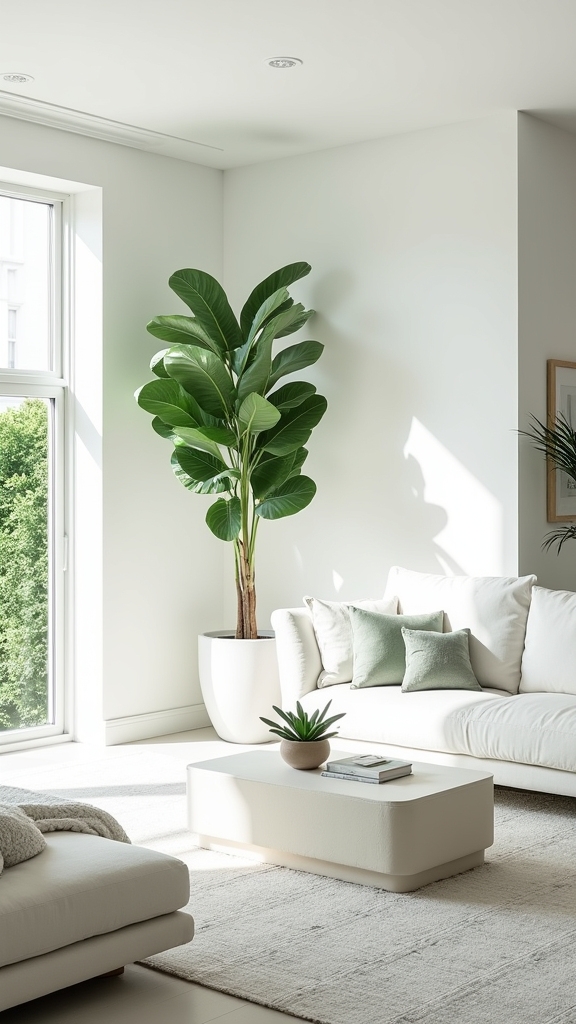
Frequently, the introduction of greenery serves as a strategic counterbalance to the starkness of a white living room, infusing organic significance while upholding minimalist integrity. Designers often bring in greenery to add warmth, subtle movement, and essential color contrast within a restrained palette. Selecting sculptural plants—such as snake plants, pothos, and fiddle leaf figs—reinforces clean lines and architectural forms without visual clutter. Neutral-toned or monochromatic planters guarantee the foliage remains the focal point, heightening visual impact. Vertical installations like hanging or wall-mounted planters optimize spatial flow and introduce layered dimension. Consistent placement of greenery not only enhances aesthetic sophistication but also improves air quality, aligning with minimalist values. The table below highlights ideal plant choices for modern white spaces:
| Plant Type | Planter Finish | Placement Style |
|---|---|---|
| Snake Plant | Matte Ceramic | Floor or Corner |
| Pothos | White Porcelain | Hanging or Shelf |
| Fiddle Leaf Fig | Concrete | Statement Piece |
| Succulent Assort. | Glass or Metal | Coffee Table Accent |
Create a Coastal Vibe
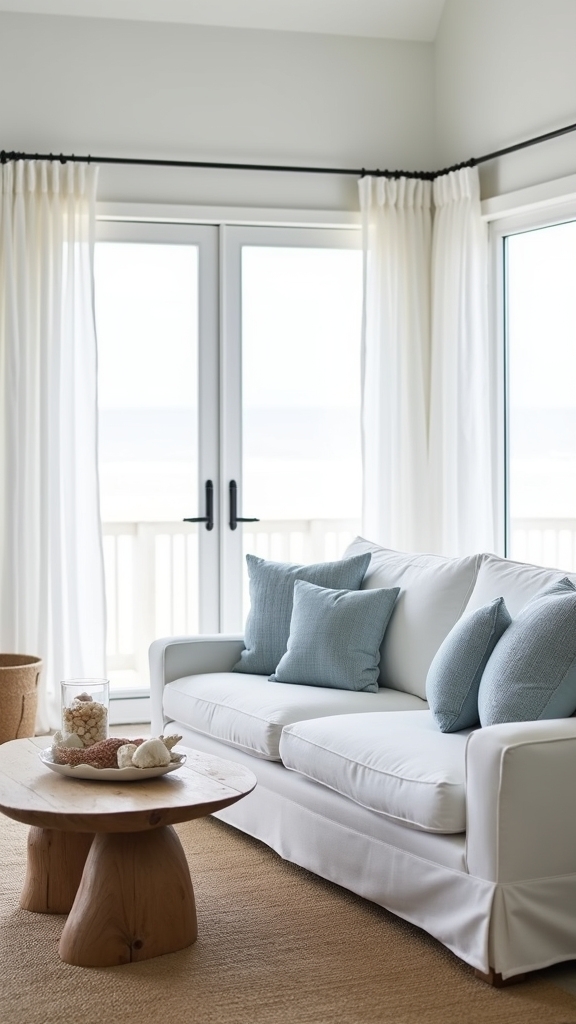
By integrating crisp white walls with strategic blue accents, a white living room effortlessly channels a coastal sensibility rooted in tranquility and simplicity.
The interplay of cool hues and natural textures is fundamental in evoking a refined coastal vibe. Expert designers emphasize the importance of light—sheer window treatments or unadorned windows maximize daylight, reinforcing the room’s open, airy quality. Layering organic materials, such as jute rugs and driftwood accessories, introduces tactile richness without disrupting the minimalist intent. Opt for lightweight, versatile furniture like wicker or rattan to maximize space and enhance the beach-inspired look.
- Serene Atmosphere: White and blue palettes invoke the calm of ocean vistas, offering visual respite and emotional clarity.
- Inviting Warmth: Natural wood elements in furnishings soften the overall aesthetic, echoing sun-bleached boardwalks.
- Effortless Depth: Textured fabrics and curated nautical decor provide subtle visual intrigue, enriching the coastal vibe.
Play With Scale and Proportion
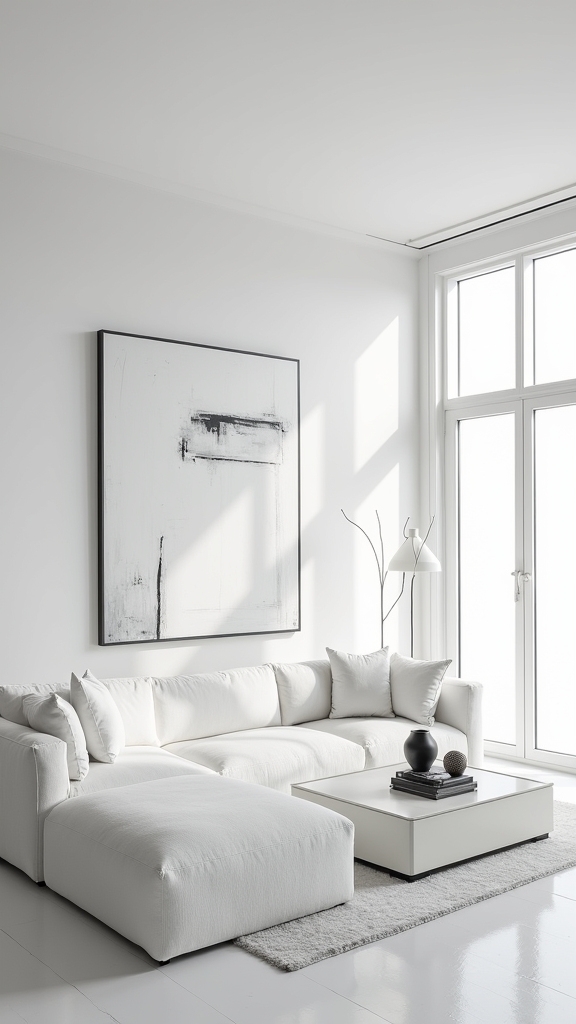
Achieving visual harmony in a white living room relies on a deliberate approach to scale and proportion, where each furnishing and accent is meticulously chosen to complement the spatial context.
In minimalist interiors, prioritizing smaller-scale furniture maximizes usable space and maintains a clean, uncluttered aesthetic—especially crucial in compact living areas. Nesting tables, for example, introduce flexibility and adaptability without disrupting the spatial flow, unlike bulkier alternatives.
Expertly balancing scale is essential: juxtaposing a low-profile sofa with tall, slender floor lamps introduces dynamic contrast, enhancing spatial interest while retaining cohesion.
Carefully considering the proportion of each decor element prevents overcrowding and preserves the light, airy atmosphere fundamental to modern minimalism.
Ultimately, successful manipulation of scale and proportion underpins a sophisticated, visually engaging white living room.
Frequently Asked Questions
What Color Goes With a White Living Room?
Selecting complementary accent colors, such as soft pastels or bold hues, enhances spatial harmony in a white living room. Thoughtful furniture choices in warm neutrals or natural wood tones introduce visual depth, adhering to minimalist design principles and expert aesthetics.
What Is the 2/3 Rule for Living Rooms?
The 2/3 rule in living room layout is a design principle recommending that furniture and decor collectively occupy no more than two-thirds of the wall height, optimizing visual balance, spatial harmony, and maintaining an uncluttered, modern aesthetic.
What Is Modern Minimalist Style?
Modern minimalist style fuses modern design with minimalist decor, emphasizing clean lines, open spaces, and functional elements. Expert design principles prioritize neutral palettes, uncluttered arrangements, and textural contrasts, fostering visual harmony and a serene, intentional aesthetic throughout the environment.
How to Decorate a Living Room Minimally?
To decorate a living room minimally, designers emphasize intentional furniture selection, prioritize space optimization, and utilize a restrained color palette. Strategic placement of functional pieces and curated decor create visual clarity, while layered textures add depth within a simplified aesthetic.
Conclusion
A modern white living room thrives on the interplay of minimalistic forms, tactile layering, and intentional contrasts. By utilizing natural light, curated art, and sculptural lighting, designers can evoke visual dynamism within a restrained palette. Integrating organic greenery and thoughtful scale manipulation further enhances spatial harmony. Ultimately, these white living room ideas demonstrate that sophistication and warmth arise from deliberate design choices, creating serene yet visually compelling environments rooted in contemporary minimalism.
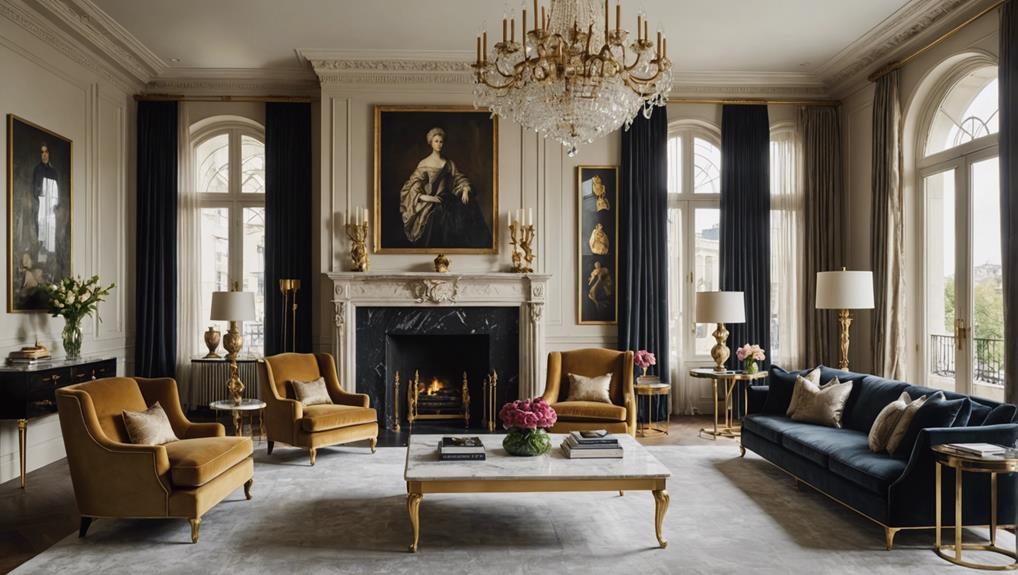
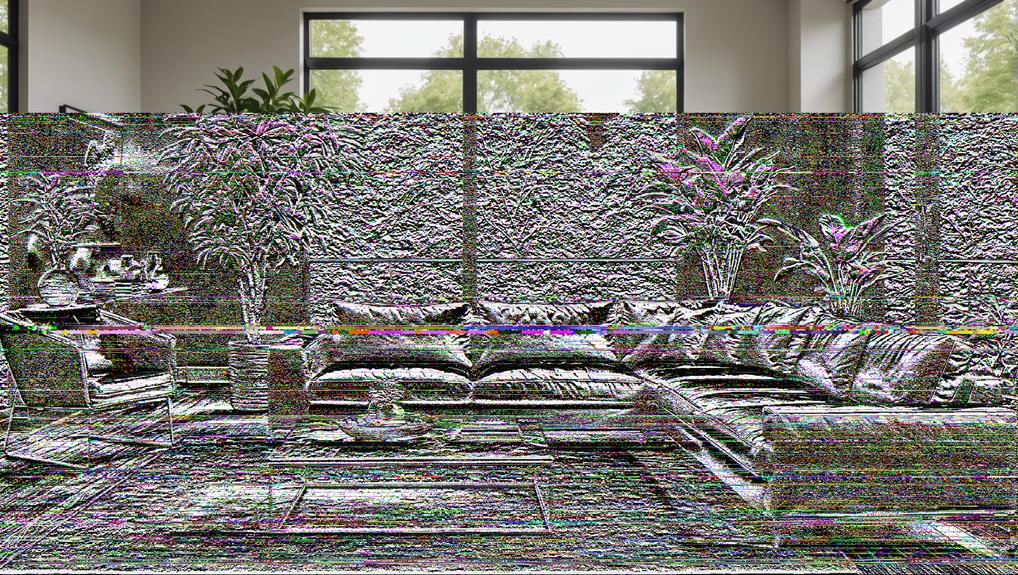
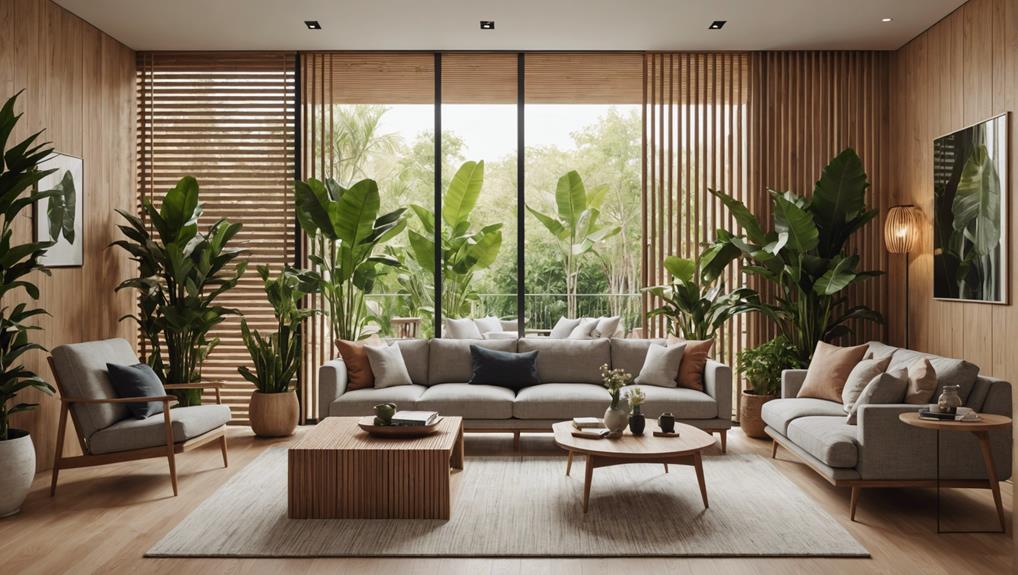
Leave a Reply